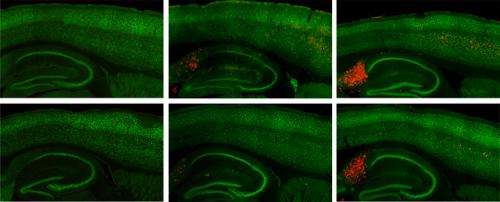New, improved mouse model of human Alzheimer's may enable drug discovery

Researchers at the University of Illinois at Chicago College of Medicine have developed a transgenic mouse that carries a human gene known to increase risk of Alzheimer's 15-fold. This new mouse mimics the genetics of the human disease more closely than any of the dozen existing mouse models and may prove more useful in the development of candidate drugs to prevent or treat the disease.
The new mouse model provides new evidence for the earliest cause of Alzheimer's, researchers report in a study to be published in the December issue of the Journal of Biological Chemistry and now available online.
The model is a cross between an existing transgenic Alzheimer's mouse and a mouse carrying fully human apoE, a gene that in one of its three variants, apoE4, is the greatest genetic risk factor for Alzheimer's in the human population.
UIC biochemist Mary Jo LaDu says amyloid-beta, a peptide, or small protein, is known to underlie the disease and is a key component of the plaques observed in the brains of deceased Alzheimer's patients at autopsy. But in addition to clumping to form those large, visible plaques, the sticky molecule is also found in smaller, soluble aggregates called oligomers—which may be the actual culprit.
"Though for a long time it was thought that amyloid plaques might cause the nerve death seen in Alzheimer's, researchers now believe that the neurotoxicity may lie in the smaller, soluble, oligomeric forms," said LaDu, who is associate professor of anatomy and cell biology at the UIC College of Medicine and principal investigator of the study.
But the researchers still faced a hurdle before they could test their hypothesis about the role of oligomeric amyloid-beta, said one of her UIC coworkers.
"There are few methods for detecting the different aggregate forms of amyloid-beta," said Leon Tai, a research assistant professor working with LaDu. So, he said, the team developed a highly specific monoclonal antibody, which enabled them to assay only the specific oligomeric form of amyloid-beta.
This new monoclonal antibody, along with the new mouse model, "allowed us to identify the earliest accumulations of amyloid-beta and the differences related to the different forms of apoE," said LaDu.
The results were definitive: transgenic mice with apoE4 show an increase in the oligomeric form of amyloid-beta compared to mice carrying the other, more benign versions of apoE, providing a mechanism for apoE-induced Alzheimer's risk. Thus, previous transgenic mice lacking this interaction were poor models, say the researchers.
In addition, if oligomeric amyloid-beta is the cause of the disease, then it is also the earliest disease marker. Thus, the new model offers a clear picture of therapeutic effects on the cause of the disease not possible with the methods and models currently available.
"More than just an Alzheimer's risk factor, patients with apoE4 often respond differently to therapeutics in clinical trials, in many cases negatively," said Tai, whose background includes drug discovery. "However, preclinical compound testing in transgenic mouse models that express human apoE has not been possible until now."
"A pre-clinical model for testing these compounds has been badly needed, so we don't find ourselves in clinical trials with therapeutics that fail," said LaDu. She has begun collaborations with other researchers at UIC and worldwide to focus on drug discovery.
"We are actively working to test and develop novel compounds that we believe will benefit all Alzheimer's patients," she said.
Journal information: Journal of Biological Chemistry
Provided by University of Illinois at Chicago
















